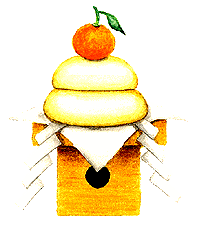ANNUAL CALENDAR January |
|
Partaking of decorative mochi (the cutting of New Year's rice cakes)
|
 New Year wouldn't be the same without mochi, which is made by steaming and pounding a sticky type of rice (mochi gome).
New Year wouldn't be the same without mochi, which is made by steaming and pounding a sticky type of rice (mochi gome).
In the past, mochi was made at home, but most families today buy it ready-made. Over the holidays, a pair of round mochi (kagami mochi) the size of plates--one a little larger than the other--is stacked on a stand and placed in a household Shinto altar or tokonoma (alcove) as an offering to the deities that visit on New Year's. The ornamental mochi is removed on January 11 and broken into smaller pieces before being eaten. By this time, the kagami mochi is usually quite brittle, and cracks appear on the surface. The mochi is not cut with a knife, since cutting has negative connotations (like "cutting off ties"). It's broken with one's hands or a hammer, and thus the ritual is called kagami biraki, or cracking open the kagami mochi. The smaller pieces are roasted and put in shiruko (sweet soup of boiled beans) or zoni (vegetable and meat soup). By partaking of this offering to the gods, ancient people believed that they were inviting divine blessings. Kagami biraki is not just a household affair. The Kodokan, a famous judo school in Tokyo, performs a mammoth kagami biraki ritual after a training session each year--a tradition going back to 1884. The mochi is put in shiruko and shared by some 700 participants.
Image: The kagami mochi in its proper arrangement. |
APR | MAY | JUN | JUL | AUG | SEP | OCT | NOV | DEC | JAN | FEB | MAR |
 |